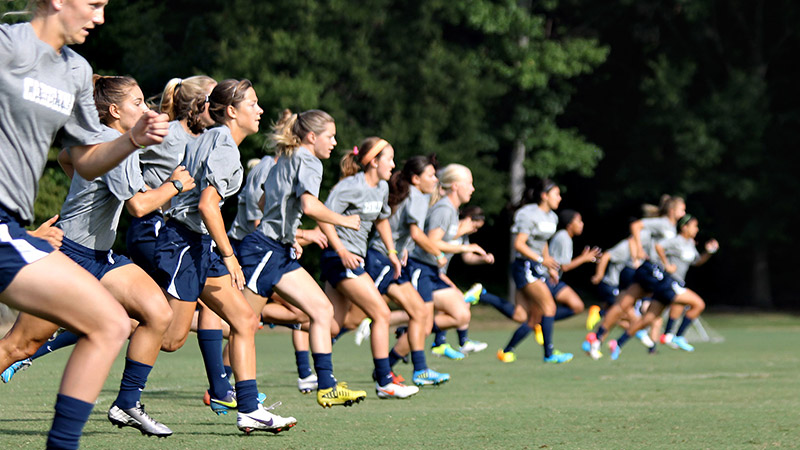
The Importance of Aerobic Fitness in Soccer
Soccer is a game of performing short bursts of high effort sprints and changes of direction over 90 or more minutes. Because of the nature of the sport, lately I’ve seen a lot of social media posts and players emphasizing only training as such, doing repeated short distance sprints or different types of shuttle runs. Although this will still help players, they’re missing out on a giant component of their match fitness, aerobic fitness!
Aerobic fitness is simply a players ability to use oxygen to create energy to sustain the activity they’re doing. Although we instantly think of runners or marathoners, aerobic fitness is more important to athletes, especially soccer players, than most believe it to be. There have been multiple studies on how aerobic fitness plays a role in repeated sprint ability with various groups including professional or high-level collegiate soccer players. These studies have found that players with a higher Vo2 max, the maximum amount of oxygen your body can use during exercise, have superior performance levels in comparison to the players with lower Vo2 max scores. Vo2 max scores have also been shown to be a key difference between amateur and professional players, as professional players have higher scores than their counterparts.
Contrary to what some may think, being more aerobically fit doesn’t automatically slow players down. The aerobic system plays a giant role in recovery between bouts of high intense effort and allows players to continuously complete high intensity movements. With this information in mind, soccer players should look to improve their aerobic fitness. Below I’ll go over two training methods I find useful to improve aerobic fitness that I learned from Joel Jamieson, a conditioning coach who’s trained countless professional athletes along with multiple time world MMA champion Demetrius “Mighty Mouse” Johnson.
Cardiac Output
This is a straightforward but effective training method to improve your aerobic fitness. Players can pick a variety of different modalities – biking, swimming, running, jumping rope, etc, that they can continuously perform for 35-60 minutes. I would rather have players run because it mostly mimics the sport but any activity works. If players have a heart rate monitor, they need to keep their BPM (beats per minute) between 130-150 because we’re targeting the heart rate that makes the body use oxygen as the main source of energy. If no heart rate monitor is available, on a scale 1 to 10, 10 being very difficult, players should look to keep the difficulty of the exercise between a 4-6. And this method can contain a mixture of different activities such as splitting the workout in half by running for 30 minutes and then jumping rope the last 30 minutes. As long as the heart rate is held between 130-150 throughout, the athlete can have any combination of exercises. This shouldn’t feel super difficult but this method focuses on the body’s ability to use oxygen, helping an athlete improve their aerobic fitness. As a player’s aerobic fitness improves they should be able to complete more work/cover more distance in the allotted time while keeping their heart rate still in the 130-150 ranges.
Tempo Intervals
The second method to advance a player’s aerobic fitness is by using tempo intervals. This method involves players exerting 70% of a maximum effort run for 10-12 seconds for 10-15 reps and resting 60s between reps or until they feel like they’re at a 3-4 on that 1 to 10 scale. They should focus on their breathing and recovery between the reps. It can be difficult but players should try to only run at 70%, having their heart rate reach the lower 150s BPM. This method helps improve local muscle endurance and allows players to practice their breathing and recovery between each rep. This method should be done in a space that the player can run continuously, or simply on a treadmill. Players can see the improvement of their aerobic fitness in this method by seeing how much more their heart rate recovers between each run and/or by being able to complete more runs.
Thébault, Nicolas1,2; Léger, Luc A1; Passelergue, Philippe2 Repeated-Sprint Ability and Aerobic Fitness, Journal of Strength and Conditioning Research: October 2011 – Volume 25 – Issue 10 – p 2857-2865
doi: 10.1519/JSC.0b013e318207ef37
Sanders, Gabriel J et al. “Aerobic Capacity is Related to Repeated Sprint Ability with Sprint Distances Less Than 40 Meters.” International journal of exercise science vol. 10,2 197-204. 1 Mar. 2017
Rhys M. Jones, Christian C. Cook, Liam P. Kilduff, Zoran Milanović, Nic James, Goran Sporiš, Bruno Fiorentini, Fredi Fiorentini, Anthony Turner, Goran Vučković, “Relationship between Repeated Sprint Ability and Aerobic Capacity in Professional Soccer Players”, The Scientific World Journal, vol. 2013, Article ID 952350, 5 pages, 2013. https://doi.org/10.1155/2013/952350
Brandon Brelsford is one of the trainers at Olympia Fitness and Performance. He graduated from Rhode Island College with a B.S. in Community Health and Wellness with a concentration in Wellness and Movement Studies. After graduating, Brandon obtained his CSCS (certified strength and conditioning specialist) from the NSCA. Brandon enjoys helping his clients realize what they’re truly capable of and enjoys seeing their growth in and out of the gym.

